#ancient artifacts
Explore tagged Tumblr posts
Text

A 1,700-Year-Old Roman Sarcophagus Discovered in Israel
Archaeologists in Israel have unearthed a Roman-era sarcophagus that depicts Dionysus beating Hercules in a drinking contest.
A 1,700-year-old Roman sarcophagus depicting a legendary drinking contest has been discovered in Israel, the Israel Antiquities Authority (IAA) announced Monday (June 9).
Archaeologists uncovered the artifact, which dates back to the second or third century A.D., near the ancient city of Caesarea along the country's northwest coast. The carved marble depicts a drinking contest between the demigod Hercules and Dionysus, the Greek god of wine and parties, who is equivalent to Bacchus in the Roman pantheon. Though similar scenes appear in mosaics from the same period, the find marks the first appearance of this particular story on a sarcophagus from the region.
"This sarcophagus is an extraordinary work of art," Mark Avrahami, head of artistic conservation at the IAA, said in a translated video. "There are not many sarcophagi like this, even in the world."
The 1,700-year-old sarcophagus was buried beneath a sand dune and fractured into pieces when archaeologists uncovered it as part of a series of excavations of the city. After the pieces were excavated, conservators cleaned and reassembled the parts to reveal the full scene.




One unbroken side of the marble coffin shows Hercules depicted lying on a lion skin. "He's at the end of the contest holding a cup of wine in his hand, and of course he's in this position because in the contest Dionysus, the god of wine — whom no one can defeat — emerged victorious," Nohar Shahar, an archaeologist with the IAA, said in the video.
Dionysus is shown as part of a joyful procession, surrounded by satyrs, female followers and Pan, the god of the wild. "In this case, it seems that the figures are not only celebrating — they are in fact accompanying the dead on his last journey, when drinking and dancing are transformed into a symbol of liberation and transition to life in the next world," Shahar said in a statement. "This sarcophagus offers an unusual perspective of the idea of death — not as an end, but as the beginning of a new path."


Archaeologists found the sarcophagus outside the walls of Caesarea, an ancient city by the Mediterranean Sea, alongside other marble slabs with names inscribed on them. These discoveries suggest that Caesarea wasn't only confined to within its walls, and that the surrounding area was more densely populated and rich in artifacts than archaeologists previously thought.
"This is a thought-provoking discovery reflecting how life and faith were perceived in the Roman world," IAA director-general Eli Escusido said in the statement.
The sarcophagus is undergoing thorough conservation before being made available for public viewing.
By Skyler Ware.
#'Extraordinary' Roman Sarcophagus Discovered in Israel#A 1700-Year-Old Roman Sarcophagus Discovered in Israel#ancient city of Caesarea#sarcophagus#ancient tomb#ancient grave#funeral goods#ancient artifacts#archeology#history#history news#ancient history#ancient culture#ancient civilizations#roman history#roman empire#roman art#ancient art
27 notes
·
View notes
Text
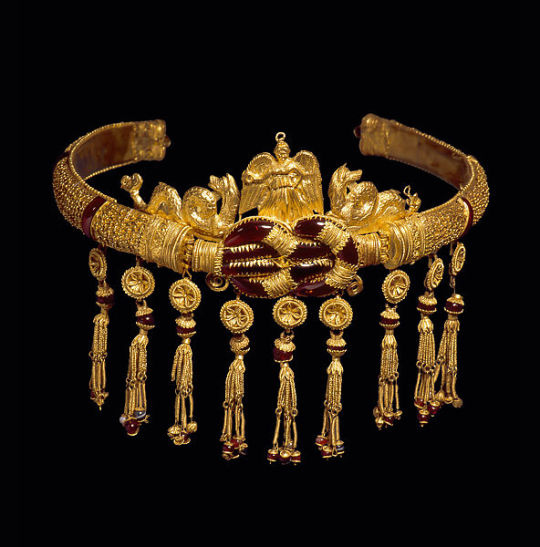
Greek Gold diadem with Hercules knot (250–150 BCE),
Gold, garnet, carnelian, sardonyx
3×9 1/8 in. (7.6 × 23.1 cm).
On loan to the Metropolitan Museum.
#greek art#ancient artifacts#ancient art#antiquities#antiquity#jewellery#archeology#met museum#art history#history#garnet#carnelian#sardonyx#heracles#hercules
3K notes
·
View notes
Text




Roman-Christian vandalism of Greek & Roman statues
in early 4th century AD, with emperor constantine's conversion to christianity, and the edict of milan (which gave freedom of religion to roman citizens, and legalised christianity) christianity had begun to overtake rome. under Constantine’s reign the suppression of paganism began, pagan places of worship lost funding, some were repurposed for christian use and some were destroyed. Constantine and his successors authorised and encouraged the burning of pagan books and the destruction and defacement of pagan temples, statues, sacred sites, art works, and anything else they believed was ‘challenging christianity’. By the late 4th century christianity had overtaken Rome, and polytheistic religion was a thing of the past.
1. defaced statue of unknown goddess, 2nd - 1st century BC, Archaeological Museum of Samos 2. bust of roman general, Germanicus, 14-20 CE, the British Museum 3. head of Aphrodite, 1st century AD, National Archaeological Museum of Athens 4. bust of Emperor Augustus, n.d, the Ephesus Museum
#ancient rome#roman empire#ancient#4th century AD#collections#archiveofmyown#statue#roman religion#roman polytheism#emperor constantine#artefact#archaeology#ancient artifacts#ancient world#classics#classical word#classical civilization
277 notes
·
View notes
Text

Octopus vase from Palaikastro
c. 1500 BCE, painted stone
#ancient artifacts#ancient art#octopus#nature#wildlife#sea life#antiquities#ancient people#ancient culture#vessel#aesthetic#beauty#modern art#art history#aesthetictumblr#tumblraesthetic#tumblrpic#tumblrpictures#tumblr art#tumblrstyle#artists on tumblr
2K notes
·
View notes
Text
beautiful things
Egyptian craftsmen;
Scarab Bracelet of Tutankhamun, made of (gold, lapis-lazuli, carnelian, turquoise, colored glass), (c.1567-1320 BC), Tomb of Tutankhamun, Valley of the Kings, West Thebes.

96 notes
·
View notes
Text
Akhnatens letters

*These are five of the Amarna letters in the british museum
The Amarna letters features letters directed to Akhnaten and before him his father about the fall of conquered terratories in Caanan and Syria to the kingdoms of the Mitanni, the Babylonians and the Hittites.
These letters are featured in the opera Akhnaten in the third act and are transcribed from Samuel A.B Mercers translation from his 1939 book "Mercer, The Tel-el-Amarna Tablets". The book is hard to find so I cannot connect the letters to their correct tablets at this time but I will when I get ahold of the book.
The letters are used to paint a good picture of the severe losses Egypt suffered during Akhnaten and his ancestors reign. His descendants in the 18th dynasty mitigated the issue but the 19th dynasty namely Seti I and Ramesses II probably reclaimed the most.
Letter No. 1: I have written repeatedly for troops, but they were not given and the king did not listen to the word of his servant. And I sent my messenger to the palace, but he returned empty-handed - he brought no troops. And when the people of my house saw this, they rediculed me like the governors, my brethren, and dispised me.
Letter No. 2: The king's whole land, which has begun hostilities with me, will be lost. Behold the territory of Seir, as far as Carmel; its princes are wholly lost; and hostilities prevail against me. As long as ships were upon the sea the strong arm of the king occupied Naharin and Kash, but now the Apiru are occupying the king's cities. There remains not one prince to my lord, the king; every one is ruined. Let the king take care of his land and let him send troops. For if no troops come in this year, the whole territory of my lord, the king, will perish. If there are no troops in this year, let the king send his officer to fetch me and his brothers, that we may die with our lord, the king.
Note: Naharin meant the land of the Mitanni claimed by Thutmose III in his military campaign.
Letter No. 3: Verily, they father did not march forth nor inspect the lands of the vassal-princes. And when thou ascended the throne of thy father's house, Abdashirta's sons took the king's lands for themselves. Creatures of the king of Mittani are they, and of the king of Babylon and of the king of the Hittites.
Letter No. 4 Who formerly could have plundered Tunip without being plundered by Thutmose III? The gods of the king of Egypt, my lord, dwell in Tunip. May my lord ask his old men if this not be so. Now, however, we belong no more to our lord, the king of Egypt. And now Tunip, thy city, weeps and her tears are flowing and there is not help for us. For twenty years we have been sending to our lord, the king of Egypt, but there has not come to us a word - no, not one.
#egyptology#ancient artifacts#hittite empire#ancient civilizations#ancient world#antiquity#archeology#ancient history#ancient artefacts#artefact#akhenaten#opera#philip glass#bronze age#mitanni#egypt#ancient egypt#egyptian history#egyptian#ancient#akhnaten
108 notes
·
View notes
Text
Witness to a Tragedy: The Discovery of the Polyxena Sarcophagus
In 1994, during a rescue excavation at the Kızöldün Tumulus near Biga in Çanakkale Province, Türkiye, archaeologists unearthed a remarkable artifact: the Polyxena Sarcophagus.
Dating back to approximately 520–500 BCE, this marble sarcophagus is considered the earliest known example in Anatolia featuring figural reliefs.
The sarcophagus is adorned with intricate carvings depicting scenes from the life and tragic death of Polyxena, the youngest daughter of King Priam and Queen Hecuba of Troy.
One side illustrates her sacrifice by Neoptolemos, son of Achilles, at the tomb of his father — a poignant moment rooted in Greek mythology.
Another panel portrays Queen Hecuba mourning beneath a barren tree, while additional sides show ceremonial processions with musicians and dancers.
Interestingly, despite the sarcophagus's association with Polyxena, it contained the remains of a 40-year-old man, suggesting it may have served a symbolic or commemorative purpose rather than being her actual tomb.
Today, the Polyxena Sarcophagus is prominently displayed at the Troy Museum in Tevfikiye village, near the ancient city of Troy.
The museum, inaugurated in 2018, houses over 2,000 artifacts that chronicle the rich history of the region.
In a contemporary reflection on the themes depicted, the museum covered the sarcophagus with a black cloth on 25 November 2024 to mark the International Day for the Elimination of Violence Against Women.
This act aimed to highlight the enduring issue of violence against women, connecting ancient narratives to present-day concerns.
#Polyxena Sarcophagus#Kızöldün Tumulus#Biga#Çanakkale Province#Türkiye#archaeology#artifact#Anatolia#figurial reliefs#marble sarcophagus#sarcophagus#Polyxena#King Priam#Queen Hecuba of Troy#Neoptolemos#Achilles#greek mythology#Troy Museum#Troy#International Day for the Elimination of Violence Against Women#ancient civilizations#ancient artifacts
88 notes
·
View notes
Note
Do we know anything about dwarven technology and/or magic? They are said to have the lowest magical potential, but I remember a picture of dwaves using a stationary phone of some kind and it seemed like there was an undine in one of the mechanisms and a dwarf having ancient magic markings in daydream portraits. They seem to have a lot of technology and magic things going on, but I can't find any info on it.
We only see a little bit of it, I was also wondering about what seems like magic tattoos in the dwarf page, perhaps is another type of tattoo instead? Or maybe it has to do with why that dwarf has a strange look on his face

The other one with similar head tattoos has half of his body burnt

Could be a warrior thing? I don't think it's the same as the magic ones, they canonically have the lowest mana reserve so I doubt they can use much magic if at all?
The tech they use seem to have to do with the ancient war when apparently there was a tech boom, but most of it apparently was buried along with dungeons.


We only see these important guys messing with something similar

226 notes
·
View notes
Text
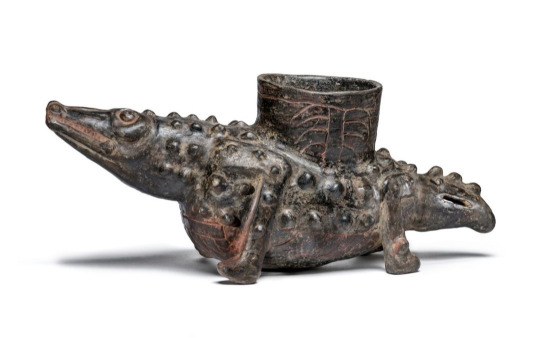
Mayan croc vessel, Mexico AD 300-600, Los Angeles Country Museum of Art
417 notes
·
View notes
Text

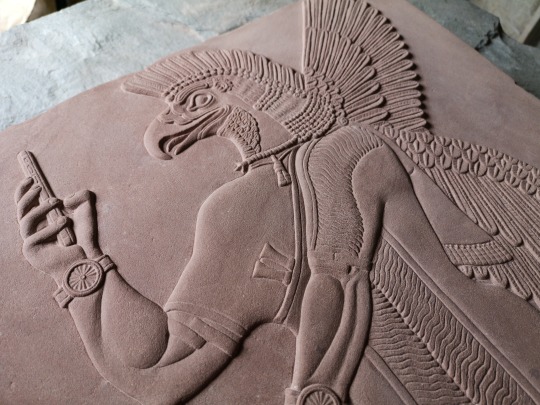

Out of place artifact.
Hand carved sandstone, based on an ancient Assyrian Winged Genie, but with a twist.
#carving#stone carving#art#traditional art#sculpture#assyrian#ancient history#archeology#history#ancient artifacts#mesopotamian art#mesopotamia#mesopotamian#genie#ancient art#ancientmonuments#antiquities#neoassyrian
536 notes
·
View notes
Text
youtube
Credit Card Imprinters --- How were credit card payments made before instant electronic point of sale?
from Payment Village
28 notes
·
View notes
Text

A 1,500-Year-Old Underground Byzantine Tomb Complex Found in Syria
A contractor digging into the earth where the rubble of a destroyed house had been cleared away in northern Syria stumbled across a surprise: the remains of an underground Byzantine tomb complex believed to be more than 1,500 years old.
The discovery emerged last month in the town of Maarat al-Numan in Idlib province , which is strategically located on the route between the cities of Aleppo and Damascus. The community became a touchpoint in the nearly 14-year Syrian civil war that ended with the fall of former President Bashar Assad in a lightning rebel offensive in December.
Assad’s forces seized the area back from opposition control in 2020. Houses were looted and demolished. Aerial images of the area show many houses still standing but without roofs.
Now residents are beginning to return and rebuild . In the course of a reconstruction project, stone openings were uncovered indicating the presence of ancient graves. Residents notified the directorate of antiquities, which dispatched a specialized team to inspect and secure the site.
Aboveground, it’s a residential neighborhood with rows of cinder-block buildings, many of them damaged in the war. Next to one of those buildings, a pit leads down to the openings of two burial chambers, each containing six stone tombs. The sign of the cross is etched into the top of one stone column.
“Based on the presence of the cross and the pottery and glass pieces that were found, this tomb dates back to the Byzantine era,” said Hassan al-Ismail, director of antiquities in Idlib. He noted that the discovery adds to an already rich collection of archeological sites in the area.


Idlib “has a third of the monuments of Syria, containing 800 archaeological sites in addition to an ancient city,” al-Ismail said.
The Byzantine Empire, which began in the 4th century AD, was a continuation of the Roman empire with its capital in Constantinople — today’s Istanbul — and Christianity as its official religion.
Abandoned Byzantine-era settlements called Dead Cities stretch across rocky hills and plains in northwest Syria, their weathered limestone ruins featuring remnants of stone houses, basilicas, tombs and colonnaded streets.
In the past, the owners of sites where archeological ruins were found sometimes covered them up, fearful that their property would be seized to preserve the ruins, said Ghiath Sheikh Diab, a resident of Maarat al-Numan who witnessed the moment when the tomb complex was uncovered.
He said he hoped the new government will fairly compensate property owners in such cases and provide assistance to the displaced people who have returned to the area to find their homes destroyed.


The years of war led to significant damage to Syria’s archeological sites, not only from bombing but from looting and unauthorized digging.
Some see in the ruins a sign of hope for economic renewal.
Another local resident, Abed Jaafar, came with his son to explore the newly discovered tombs and take pictures.
“In the old days, a lot of foreign tourists used to come to Maarat just to see the ruins,” he said. “We need to take care of the antiquities and restore them and return them to the way they were before … and this will help to bring back the tourism and the economy.”
By Omar Albam and Abby Sewell.

#A 1500-Year-Old Underground Byzantine Tomb Complex Found in Syria#Maarat al-Numan#ancient tomb#ancient grave#funeral goods#ancient artifacts#archeology#history#history news#ancient history#ancient culture#ancient civilizations#byzantine empire
22 notes
·
View notes
Text
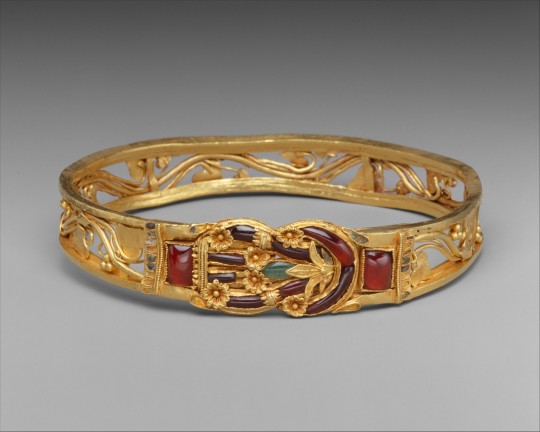
Gold armband with Herakles knot
Hellenistic period
3rd–2nd century BCE
Gold inlaid with garnets, emeralds, and enamel
3 1/2in. (8.9cm)
The Herakles knot on this sumptuous armband is enriched with floral decoration and inlaid with garnets, emeralds, and enamel. According to the Roman writer Pliny, the decorative device of the Herakles knot could cure wounds, and its popularity in Hellenistic jewelry suggests that it was thought to have the power to avert evil.
from The Metropolitan Museum of Art, New York
#greek art#hellenistic art#ancient artifacts#ancient art#antiquities#art history#archeology#hercules#carnelian#met museum#herakles
684 notes
·
View notes
Text
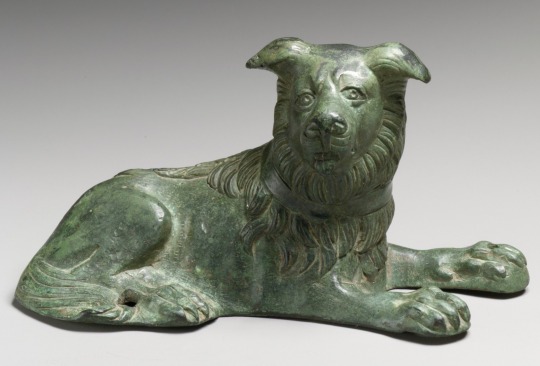
Bronze statuette of a dog
Roman
2nd-3rd century CE
#roman art#dogs#bronze#bronze statue#animals in art#ancient art#ancient people#ancient statue#statue aesthetic#aesthetic#beauty#ancient artifacts#artifacts#antiquities#beautiful animals#dogs of tumblr#cute dogs#modern art#art history#aesthetictumblr#tumblraesthetic#tumblrpic#tumblrpictures#tumblr art#tumblrstyle#artists on tumblr
2K notes
·
View notes
Text








this is also a png blog now. carved artifacts from the Penn Museum.
#photography#iphone photography#transparent#png#ancient art#ancient artifacts#penn museum#philadelphia#pngs#transparent png#aesthetic pngs#carving#stone carvings#history#art history
24 notes
·
View notes
Text

A Hittite cuneiform tablet declaring the first surviving recorded peace treaty in history between Ramesses II and Ḫattušili III respectivly rulers of the New Kingdom of Egypt and the empire of the Hittites. The tablet is written in the Hittite language and their cuneiform.
This is one of three known relics of the treaty. Also known as The Treaty of Kadesh.
Circa 1259 BC
The tabelt is displayed at the Museum of the Ancient Orient in Turkey
#egyptology#ancient civilizations#ancient world#antiquity#archeology#ancient history#egyptian history#ancient egypt#hittite empire#hittite#archaeology#artifacts#cuneiform#anatolia#mesopotamia#artifact#ancient artifacts
86 notes
·
View notes